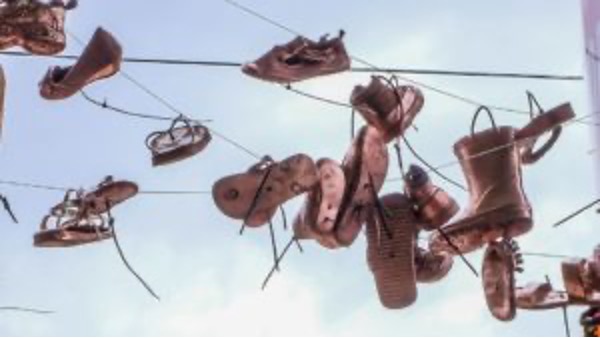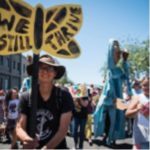
Originally published at BuddhistPeaceFellowship.org
Content note: This article references child abuse & child sexual abuse throughout, both interpersonal and state abuse, but does not share specific stories. Strategies for individual and community healing are in the second half.
Childhood abuse – especially child sexual abuse – has been my main topic of conversation since June.
I’ve heard few specific stories. Most people want to talk about how their abuse impacts their ability to show up politically, in honest ways.
People are asking big and tender questions like:
- How can I bow out of political work at this really intense time to do the healing work that I can no longer avoid?
- Am I allowed to name that my experiences of sexual abuse are part of the conditioning of my gender identity and sexual orientation?
- As a child abuse survivor who was silenced, I’ve been fighting as an adult to re-learn how express my emotions. But how do I express myself with integrity when that sometimes causes harm for others overwhelmed by emotional expression because of their own childhood abuse?
As a trained advocate for sexual abuse survivors, it’s not unusual for me to talk with people about how they’ve been harmed – particularly in the wake of the #MeToo movement and among Buddhist communities rocked by sexual abuse of power. But it is unusual for this to be an almost daily conversation across widely diverse racial and gender identities.
What has people’s childhood abuse so activated?

I traveled in July to San Diego and Portland, to support actions demanding that ICE reunify families separated at the border. These actions expanded on concerns that #FamiliesBelongTogether by demanding we #AbolishICE as an institution formed in racist fear after 9/11.
I’ve rarely traveled to support protests, yet I felt internally compelled – I had to rearrange my life to go. As I talked with friends who had also rearranged lives to protest, the conversations about child abuse continued.

And it clicked. Our own child abuse had us activated by seeing kids locked up at the border, isolated from their families, abused by the US government. It reminded us of our own stories of childhood terror at the hands of families, community, and the state. It touched our traumatic experiences of violence, violation, confusion, extreme isolation, absence of parents, and loneliness.
This is the wisdom that feminists of color of Incite have been insisting on for nearly 20 years, that interpersonal and state violence are inseparably linked. Learning from that wisdom, I’ve been an advocate for framing interpersonal and state violence together, especially to end violence against women, gender-nonconforming and trans people of color. Yet as a white person, it was a deeper internal experience for me to notice how intensely the state violence enacted on kids and families at the border triggered my own old histories of interpersonal child sexual abuse. Interpersonal and state violence are inseparably connected for us all.
As I talked with friends who were showing up to protest as allies, we were driven by a core need: I need to help these kids, the way an adult should have helped me.
This is a tender and loving reason to show up – to demand safety for children in a world that did not figure out how to protect us. These kids should be protected. I should have been protected. You should have been protected.
Yet as this understanding washed through me, I also could feel how precarious this stance would be. It’s like the child me was showing up – and while she is a fierce badass like the children showing up at the front of the San Diego march, she was going to need a snack and a nap soon. Especially because this wasn’t just any small child version of me, but the most wounded child who felt abandoned by adults, violated and terrified.
Our wounding is not a problem – in fact, it’s what gives us the power to show up for others. Our anger is a motivating force, to demand that these kinds of harms never happen again. While these families’ pain is not the same as our own pain, we have empathy to connect to what their pain might feel like.
When we show up because we feel directly impacted ourselves or in close community, it’s clear how our wounding drives us. But when we show up in allyship, can we also track how our wounding drives our commitment? Like the concept of wounded healer, we can be wounded activists – compelled into the work because of our own histories.
If we don’t know how our wounding is driving our presence, we risk running into action on adrenaline and quickly burning out. Or we risk centering our own wounds rather than the wounds of those suffering right now in this situation.
We’re seeing this now in our struggle to keep sustained attention on the family separation crisis. Our adrenaline-fueled attention has been spent and we’re now exhausted. The family separation fight struggles to stay front-page news – even as Trump’s administration fails to meet court orders to reunite hundreds of children with their families. Our wounded children – those still locked in detention centers and our inner wounded children – need us to heal enough to show up again and again for the long term.
May we be the adults that kids like us needed.
How do we strengthen our own healing practices to stay steady in this work to support immigrant families?
You may have your own community and personal healing practices that keep you engaged. Use what you know works for you! Here are a few practices that I’m finding useful right now, drawing from political and Buddhist wisdom traditions. If you try any of these and find it challenging, don’t force it — try finding one that feels more soothing or grounding instead.
1. Support kid-centered action.


Latinx leaders from Mijente in San Diego’s action made the strategic call to center kids in a beautiful march. [Shout out to BPFer Amy Hutto for making the amazing butterfly art with messages like “Free Our Future” and “We Still Thrive.”] While in my rage I want to block detention centers, celebrating the freedom and beauty of liberated children supports healing for this inner wounded child. And it’s this connection to children that keeps wider audiences engaged – audiences also drawn to this issue because of childhood wounding.
2. Practice compassion for self and others.
The first practice I learned within Buddhist traditions is a Tibetan practice called tonglen, a “sending and receiving” practice. At the time, my heart was in a great deal of suffering, and I wasn’t sure about this practice of breathing in even more suffering from the world. Yet I find this practice helps me less isolated and more compassionate for myself and others.
- Connect with a spacious feeling of clarity or simple goodness.
- As you breathe in and out, work with texture or sensation. Breathe in tension, heat, tightness; breathe out space, coolness, ease. See if you can radiate those textures in and out through all parts of the body.
- Visualize this specific situation:
- Breathe in the suffering, particularly of children and families who have been separated at the border. If you can, start with a particular person’s experience you know about through personal connection or news story.
- Let those feelings mix with your own pain.
- Breathe out radiance, brightness, compassion, and healing for these children and families.
- Let this compassion touch you as it radiates out from your being
- Let your breathing expand to connect with all people who are experiencing this – both children and families on the border, and allies who are working to heal their own pain. Breathing in suffering, breathing out ease.
3. Be mindful of simple pleasures.

As someone drawn to immigrant justice work as an ally, I can sometimes feel guilty about my access to pleasure. Yet connecting to pleasure is essential for caring for this tender wounded child.
Can I allow my senses to take in pleasure, to the extent that feels tolerable?
Can I feel the sun warming my skin?
See the volunteer sunflower open?
Taste the first tomato of the season?
Hear wind rustling leaves?
Smell the chocolate zucchini bread baking in the oven?
As a trauma survivor, I know that sensation can be a trickster – what is pleasant can turn unpleasant or even triggering with little warning. Opening the body to certain kinds of sensations can feel like a dangerous proposition. Trust your self-knowledge about what is right for your body to be open or closed to right now.
4. Witness our wounded inner children whose anger and empathy are driving us to this work, while keeping focus on present harms to immigrant communities.
As I’ve talked with people, it’s felt healing to have my history be more known by others around me. It’s also meant being mindful about where I’m supporting others and where I can receive support. For me as a white person, that’s meant seeking witnessing from other white folks with child sexual abuse histories about how I’m showing up in the movement. When I’m talking with people of color, especially those with close ties in targeted immigrant communities, I try to do more witnessing of harms they’ve experienced, rather than seek my wounds to be witnessed. I do my best at this when I’m intentional about seeking out the witnessing and support I need.
5. Cultivate joy and belonging in community and with yourself.
To resist isolation, I’ve found it important to connect with joy in community. For me, that’s looked like: singing, dancing, talking around the campfire, laughing over dinner, talking on the phone or over video conferencing, meeting an old friend for breakfast. Two beings are enough to cultivate a sense of community and connection.
If connecting with people feels difficult, you can cultivate community with pets, street cats, and the animals and trees you find in nature. If belonging feels distant for you, you might check out this practice of belonging offered by Prentis Hemphill on the Healing Justice podcast, former Healing Justice Director of Black Lives Matter and a winner of BPF’s Soma Award. Prentis helps us connect with belonging as an internal sense that we can access regardless of what’s happening on the outside.
As we care for ourselves, may this support us to stay engaged in the fight to reunite immigrant families. If you are ready for action, here’s a good place to start with five actions collected by my fellow BPF Co-Director, Katie Loncke.
Ready for more from the deep wells of spiritual + political wisdom? Check out BPF’s dialogue on Sanctuary: Spiritual Wisdom + Immigrant Justice between Black Buddhist writer and teacher Rev. Zenju Earthlyn Manuel and grassroots educator Eddy Zheng.
Rev. Zenju’s teachings as a Black Zen priest spark us into action, grounded in a deep knowing that our inter-beingness cultivates sanctuary.
Eddy’s stories about the sanctuary of spiritual practices are powerful medicine, forged during 20 years in prison, including 11 months in solitary while organizing for ethnic studies on the inside.
How does our spiritual power help us build sanctuary for ourselves and others?

Leave a Reply